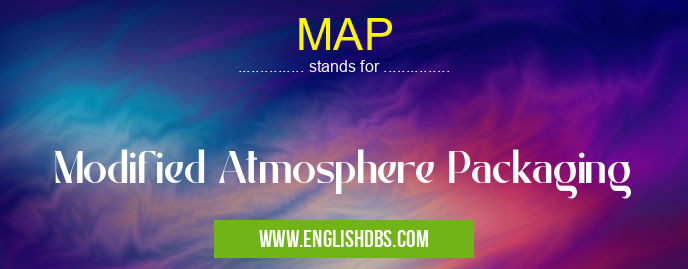What does MAP mean in ACADEMIC & SCIENCE
Modified Atmosphere Packaging (MAP) is a type of food packaging and storage method that helps preserve the freshness and longevity of different types of foods. This method involves controlling the atmosphere surrounding the product to maintain an optimal environment for the food and reduce oxygen levels, which is important for slowing down microbial growth. Other techniques can be used in conjunction with MAP, such as the addition of antimicrobial agents or changing the humidity around the product.

MAP meaning in Academic & Science in Academic & Science
MAP mostly used in an acronym Academic & Science in Category Academic & Science that means Modified Atmosphere Packaging
Shorthand: MAP,
Full Form: Modified Atmosphere Packaging
For more information of "Modified Atmosphere Packaging", see the section below.
Overview
MAP uses various methods to create a microenvironment that works to keep food fresher for longer. It starts with selecting an appropriate container, such as vacuum sealed bags, airtight containers, and cardboard boxes. The next step is to fill this container with either an inert gas or a combination of gases, depending on what type of product you are trying to store. Examples of gases that are commonly used in MAP are carbon dioxide, nitrogen, oxygen, and ethylene oxide. By controlling these levels inside the container it can help slow down respiration and microbial growth within certain types of foods.
Benefits
Using MAP can help reduce certain costs associated with food production by extending its shelf life without compromising safety or flavor quality. It also reduces wastage by keeping stored products fresher for longer periods of time without having to worry about spoilage or contamination from outside sources. In addition to reducing costs and cutting down on waste, MAP also provides environmental benefits due to decreased energy consumption during storage thanks to its efficient use of packaging materials.
Essential Questions and Answers on Modified Atmosphere Packaging in "SCIENCE»SCIENCE"
What is Modified Atmosphere Packaging?
Modified Atmosphere Packaging (MAP) is the process of changing the composition of the air surrounding food products to extend its shelf life by preventing spoilage from microbial growth. The technique involves replacing oxygen with a combination of gases such as carbon dioxide, nitrogen, and oxygen to create an environment that inhibits mold and bacterial growth.
How does MAP help preserve food?
MAP helps to preserve food by reducing oxidation processes that can cause spoilage. Reducing the oxygen content in a package slows down enzymatic reactions, microbial growth, and staling mechanisms. It also helps maintain color, flavor, and nutritional value for longer periods of time.
What kind of food is typically used with MAP packaging?
Common foods that are packaged with MAP include fish, meat, cheese, produce, snacks, bakery items and pre-prepared meals.
Why is there condensation on my food when I open my MAP package?
This is caused by temperature variation within the package or between the package and your external environment. As the temperature changes over time it can cause moisture condensation which makes it appear wet or soggy on some surfaces after opening.
Is MAP safe for children and people with allergies?
Yes! When done correctly, modified atmosphere packaging is safe for everyone including those with allergies or special dietary needs. No additional chemicals are added to the package to change its composition so consumers do not need to worry about unwanted ingredients.
Does Modified Atmosphere Packaging add any flavor or texture enhancements to the food?
No - Modied Atmosphere Packaging does not add any flavor or texture enhancements to foods beyond what you would naturally find in them prior to packaging.
Are there environmental benefits to using Modified Atmosphere Packaging?
Yes! By extending shelf life significantly this reduces waste since less product ends up going bad before consumption even begins. It also requires less energy for refrigerated transportation since it extends product life outside of cold storage for longer periods of time than normal packaging techniques can achieve
Final Words:
Modified Atmosphere Packaging (MAP) is an effective way to maintain food freshness while also saving money and being more environmentally friendly. Through careful control over atmospheric composition within a specialized container, MAP creates optimal conditions for preserving food quality while reducing energy usage during storage processes. With its many advantages and benefits it is no wonder that it has gained so much popularity in recent years as more businesses become aware of its potential applications in their operations.
MAP also stands for: |
|
| All stands for MAP |
